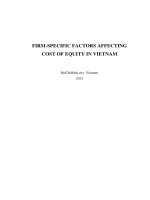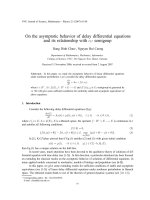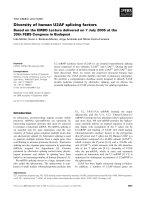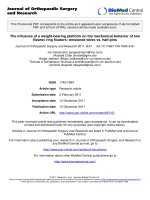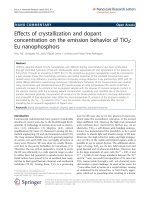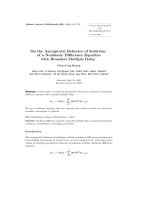Factors affecting on the job behavior at sparton corporation
Bạn đang xem bản rút gọn của tài liệu. Xem và tải ngay bản đầy đủ của tài liệu tại đây (1.07 MB, 73 trang )
RESEARCH PROJECT
FACTORS AFFECTING ON THE JOB
BEHAVIOR AT
SPARTON CORPORATION
STUDENT’S FULL NAME
: NGUYEN THANH NAM
STUDENT ID
: CGS00019386
INTAKE
: MARCH, 2015
ADVISOR’S NAME & TITLE : DR. BUI PHI HUNG
FEB, 2017
ACKNOWLEDGEMENTS
On the very outset of this report, I would like to extend my sincere &
heartfelt obligation towards all the personages who have helped me in this
endeavor. Without their active guidance, help, cooperation & encouragement, I
would not have made headway in the project.
I am extremely thankful and pay my gratitude to my faculty Dr. Bui Phi
Hung for his valuable guidance and support on completetion of this project in its
presently.
I also acknowledge with a deep sense of reverence, my gratitude towards
my family, who has always supported me morally as well as economically.
At last but no least gratitude goes to all of my friends who directly or
directly helped me to complete this project report.
Any omission in this brief acknowledgement does not mean lack of
gratitude.
Thank You
NGUYEN THANH NAM
Advisor’s Assessment
-----------------------------------------------------------------------------------------------------------------------------------------------------------------------------------------------------------------------------------------------------------------------------------------------------------------------------------------------------------------------------------------------------------------------------------------------------------------------------------------------------------------------------------------------------------------------------------------------------------------------------------------------------------------------------------------------------------------------------------------------------------------------------------------------------------------------------------------------------------------------------------------------------------------------------------------------------------------------------------------------------------------------------------------------------------------------------------------------------------------------------------------------------------------------------------------------------------------------------------------------------------------------------------------------------------------------------------------
Advisor’s signature
DR. BUI PHI HUNG
TABLE OF CONTENT
ACKNOWLEDGEMENTS ..................................................................................................
LIST OF FIGURES ..............................................................................................................
LIST OF TABLE ..................................................................................................................
EXECUTIVE SUMMARY ....................................................................................................
CHAPTER I: INTRODUCTION .................................................................................... 1
1.1 General ..................................................................................................................... 1
1.2 Medical Segment ..................................................................................................... 3
1.3 Complex Systems Segment ..................................................................................... 3
1.4 DSS Segment ........................................................................................................... 3
1.5 Risks and Uncertainties ........................................................................................... 4
1.6 Sparton Vietnam ...................................................................................................... 6
1.7 Research Introduction: ............................................................................................. 7
1.8 Goal of the Research ................................................................................................ 7
1.9 Objective of the Research ........................................................................................ 8
1.10 Limitations of the Research .................................................................................. 8
1.11 Research Questions .............................................................................................. 8
CHAPTER II: LITTERATURE REVIEW.................................................................... 9
2.1 Organization Commitment ...................................................................................... 9
2.2 Work Control ......................................................................................................... 12
2.3 Goad and Process Clarity ...................................................................................... 15
2.4 Fairness Perceptions of an Organization Policy .................................................... 16
2.5 On the Job Behaviors ............................................................................................ 20
CHAPTER III: RESEARCH MODEL AND HYPOTHESES ................................... 22
3.1 Research Model ..................................................................................................... 22
3.2 Hypotheses ............................................................................................................. 23
3.2.1 Organizational Commitment ....................................................................... 23
3.2.2
Work Control ............................................................................................... 26
3.3.3
Goal and Process Clarify ............................................................................ 29
3.3.4
Fairness Perceptions on an Organization Policy ........................................ 32
3.3.5
On the Job Behaviors.................................................................................. 36
3.3 Research Methodology .......................................................................................... 39
3.3.1 Introduction .................................................................................................. 39
3.3.2 Research design ............................................................................................ 39
3.3.3 Sampling ....................................................................................................... 39
3.3.4 Data collection method ................................................................................. 40
3.3.5 Data collection instrument ............................................................................ 41
3.3.6 Analysis of data ............................................................................................. 41
CHAPTER IV: ANALYSIS AND RESULT ................................................................ 43
4.1 Demographic Characteristics of the respondents .................................................. 43
4.2 Reliability Analysis ............................................................................................... 44
4.3 Descriptive Statistic............................................................................................... 45
4.4 Correlation of all variables statistics ..................................................................... 46
4.5 Hypotheses Testing ............................................................................................... 48
CHAPTER V: CONCLUSION ..................................................................................... 50
5.1 Summary and Discussion ....................................................................................... 50
5.2 Management Implications...................................................................................... 51
5.3 Limitations and Recommendation for Further Research: ...................................... 53
REFERENCES................................................................................................................ 55
APPENDIX ..................................................................................................................... 59
LIST OF FIGURES
Figure 1: Financial highlights of Sparton Corporation .............................................. 2
Figure 2: Hypothesized Research Model ................................................................... 22
Figure 3: Correlation of all independent variables with dependent variable
..................................................................................................................................
47
LIST OF TABLE
Table 1: Summary of Cronbach’s Alpha of the variables ..........................................44
Table 2: Descriptive Statistics ................................................................................... 45
Table 3: Summary of Correlations of all variables ................................................... 47
Table 4: Model Summary of all hypotheses .............................................................. 48
Table 5: Coefficients of all hypotheses .................................................................... 48
EXECUTIVE SUMMARY
The success of an organization is widely believed to stem from individuals’
contributions and its fellows are precious assets of an institution. This is especially
true for Sparton Corporation.
Sparton Corporation is currently facing challenges is in recently some
employees have intention to leave Sparton Corporation after being a long time in
service. Accordingly, identifying the factors affecting the levels of organization
commitment to attract employee’s cooperation and contributions in the long time is
critical. Being able to tackle this mission will bring about a desirable success for
Sparton Corporation in the Human Resource Management.
The theoretical framework of this study will be tested by collecting data from
300 Sparton Corporation employees in the Office and Production floor. They are
provided their ideas in the trial and official surveying processes. The reliability
analysis, descriptive analysis, and hypothesis testing were employed to analyze the
data.
The purpose of the study is to explore factors affecting to the organizational
commitment of employees in Sparton Corporation through a questionnaire.
Following the analysis process, factors collected are Organizational Commitment,
Work Control, Goal and Process Clarity, Fairness Perceptions on an Organization
Policy and On The Job Behaviors.
The interpretation of collected data will be followed by the researcher’s
strategic recommendations related to organizational commitment. In spite of
unavoidable limitations, the research outcomes are expected to be a possible
constructive source for Sparton Corporation to refer in planning and developing the
strategies to enhance the organizational commitment of the employees.
Key words: On The Job Behaviors, Organizational Commitment, Work Control,
Goal and Process Clarity and Fairness Perceptions on an Organization Policy
CHAPTER I: INTRODUCTION
1.1
General
Sparton Corporation and subsidiaries (the “Company” or “Sparton”) has been in
continuous existence since 1900. It was last reorganized in 1919 as an Ohio
corporation. The Company is a provider of design, development, and manufacturing
services for complex electromechanical devices, as well as sophisticated engineered
products complementary to the same electromechanical value stream. The Company
serves the Medical & Biotechnology, Military & Aerospace and Industrial &
Commercial markets through three reportable business segments; Medical Device
(“Medical”), Complex Systems (“CS”) and Defense & Security Systems (“DSS. All
of the Company’s facilities are certified to one or more of the ISO/AS standards,
including ISO 9001, AS9100 or ISO 13485, with most having additional
certifications based on the needs of the customers they serve. The Company’s
products and services include offerings for Original Equipment Manufacturers
(“OEM”) and Emerging Technology (“ET”) customers that utilize microprocessorbased systems which include transducers, printed circuit boards and assemblies,
senso9rs, and electromechanical components, as well as development and design
engineering services relating to these product sales. Sparton also develops and
manufactures sonobuoys, anti-submarine warfare (“ASW”) devices used by the
United States Navy and other free-world countries. Many of the physical and
technical attributes in the production of sonobuoys are similar to those required in
the production of the Company’s other electrical and electromechanical products
and assemblies.
The Company uses an internal management reporting system, which provides
important financial data to evaluate performance and allocate the Company’s
resources on a segment basis. Net sales are attributed to the segment in which the
product is manufactured or service is performed. A segment’s performance is
evaluated based upon its operating income (loss).
Page 1
A segment’s operating income (loss) includes its gross profit on sales less its
selling and administrative expenses, including allocations of certain corporate
operating expenses.
Certain corporate operating expenses are allocated to segment results based on
the nature of the service provided. Other corporate operating expenses, including
certain administrative, financial and human resource activities as well as items such
as interest expense, interest income, other income (expense) and income tax
expense (benefit), are not allocated to operations and are excluded from segment
profit.
These costs are not allocated to the segments, as management excludes such
costs when assessing the performance of the segments. Inter-segment transactions
are generally accounted for at amounts that approximate arm’s length transactions.
Identifiable assets by segments are those assets that are used in each segment’s
operations. The accounting policies for each of the segments are the same as for the
Company taken as a whole.
Financial Highlights:
Figure 1: Financial highlights of Sparton Corporation (source: Sparton annual report)
Page 2
1.2
Medical Segment
Medical segment operations are comprised of contract design, manufacturing,
and aftermarket repair and refurbishment of sophisticated
medical
and
biotechnology devices and sub-assemblies. Customers include industry leaders,
emerging technologies companies and start-ups. In manufacturing devices for its
customers, this business unit follows specific design and manufacturing processes to
assure product reliability and safety in accordance with Food and Drug
Administration (“FDA”) guidelines and approvals. This group specializes in 27
technologies, systems and processes required by medical OEM and ET customers
primarily in the diagnostic, therapeutic, surgical and laboratory device segments of
the medical and biotechnology marketplaces. The Medical segment also includes
some non-medical customers.
1.3
Complex Systems Segment
Complex Systems segment operations are comprised of manufacturing and
aftermarket repair and refurbishment of
sophisticated
printed
circuit
card
assemblies, sub-assemblies, full product assemblies, and cable/wire harnesses.
Customers include military and aerospace, as well as industrial and commercial
OEM’s. In manufacturing for its customers, this segment adheres to very strict
military and aerospace specifications in addition to product and process
certifications. Customers are primarily engaged in applications that include: flight
controls, industrial and military control systems, cockpit displays, fuel system
controls, secure communications, early warning detection, security systems, satellite
communications, and audio. The CS segment also
includes
some
medical
customers.
1.4
DSS Segment
Defense & Security segment operations are comprised of design, development
and production of products for both domestic and foreign defense as well as
Page 3
commercial
needs.
Sparton
designs
and
manufactures
antisubmarine
warfare (“ASW”) devices known as sonobuoys for the U.S. Navy and foreign
governments that meet Department of State licensing requirements. This segment
also performs an engineering development function for the United States military
and prime defense contractors for advanced technologies ultimately leading to
future defense products as well as replacements for existing products. The sonobuoy
product line is built to stringent military specifications. These products are restricted
by International Tariff and Arms Regulations (“ITAR”) and qualified by the U.S.
Navy, which limits opportunities for competition. Sparton is also a provider of
ruggedized flat panel display systems for military panel PC workstations, air traffic
control and industrial applications. Ruggedized displays are manufactured for prime
contractors to specific military grade specifications. Additionally, this business unit
internally develops and markets commercial products for underwater acoustics and
microelectromechanical (“MEMS”)-based inertial measurement.
1.5
Risks and Uncertainties
Sparton, as a high-mix, low to medium volume supplier, provides rapid product
turnaround for customers. High-mix describes customers needing multiple product
types with generally low to medium volume manufacturing runs. As a contract
manufacturer with customers in a variety of markets, the Company has substantially
less visibility of end user demand and, therefore, forecasting sales can be
problematic. Customers may cancel their orders, change production quantities
and/or reschedule production for a number of reasons. Depressed economic
conditions may result in customers delaying delivery of product, or the placement of
purchase orders for lower volumes than previously anticipated. Unplanned
cancellations, reductions, or delays by customers may negatively impact the
Company’s results of operations. As many of the Company’s costs and operating
expenses are relatively fixed within given ranges of production, a reduction in
customer demand can disproportionately affect the Company’s gross margins and
Page 4
operating income. The majority of the Company’s sales have historically come from
a limited number of customers. Significant reductions in sales to, or a loss of, one
of these customers could materially impact our operating results if the Company
were not able to replace those sales with new business.
Other risks and uncertainties that may affect our operations, performance,
growth forecasts and business results include, but are not limited to, timing and
fluctuations in U.S. and/or world economies, sharp volatility of world financial
markets over a short period of time, competition in the overall
contract
manufacturing business, availability of production labor and management services
under terms acceptable to the Company, Congressional budget outlays for sonobuoy
development and production, Congressional legislation, uncertainties associated
with the outcome of litigation, changes in the interpretation of environmental laws
and the uncertainties of 28 environmental remediation and customer labor and work
strikes.
Further risk factors are the availability and cost of materials, as well as noncancelable purchase orders we have committed to in relation to customer forecasts
that can be subject to change.
A number of events can impact these risks and uncertainties, including potential
escalating utility and other related costs due to natural disasters, as well as political
uncertainties such as the unrest in Africa and the Middle East and increased tension
between Vietnam and China over oil rights in the South China Sea.
Additional trends, risks and uncertainties include dependence on key personnel,
risks surrounding acquisitions, uncertainties surrounding the global economy, U.S.
healthcare legislation, U.S. budget sequestration and debt ceiling negotiations and
the effects of those uncertainties on OEM behavior, including heightened inventory
management, product development cycles and outsourcing strategies. Finally, the
SarbanesOxley Act, and more recently the Dodd-Frank Act, have required or will
require changes in, and formalization of, some of the Company’s corporate
governance and compliance practices. The SEC and the New York Stock Exchange
Page 5
have also passed or will pass related rules and regulations requiring additional
compliance activities, including those implementing the conflict minerals
provisions of the Dodd-Frank Act. Compliance with these rules has increased
administrative costs and may increase these costs further in the future. A further
discussion of the Company’s risk factors has been included in Part I, Item 1A, “Risk
Factors”, of this Annual Report on Form 10-K. Management cautions readers not to
place undue reliance on forward-looking statements, which are subject to influence
by the enumerated risk factors as well as unanticipated future events.
1.6
Sparton Vietnam:
Sparton Viet Nam, is a wholly-owned subsidiary of Sparton Corporation, U.S.A.
Built in 2005, Sparton Viet Nam has acquired the latest technology and equipment
available, housed in a modern 55,000 square foot plant. Everything from
manufacturing, material procurement, logistics, RoHS and WEEE, through
technological enhancements and managerial support provides Sparton with over 110
years of experience.
Sparton Viet Nam is a full-service electronics manufacturing service provider.
Prototyping, printed circuit board assembly, design services, design for various test,
component obsolescence management, material procurement, box-build, repair
Page 6
depot are among Sparton’s offerings. To excel at its core competencies,
Sparton focuses its attention on specific markets such as aerospace, industrial,
medical, instrumentation & commercial electronics.
Representatives: Drew Graham Richmond, Deputy General Director Address:
No.3, Street No. 6, Vietnam – Singapore Industrial Park I
Thuan An District, Binh
Duong Province
1.7
Research Introduction:
Significant of Research
As introduced above, to serve for world class customers with products that
are required absolute safety for users such aerospace and medical parts, Sparton has
invested billions of dollars of dollars for the goods factory, machines, equipment
and supported management systems. However, to operate the newest modern
machines, equipment and own the advanced technologies as mentioned above,
company need to have talent staffs, high skills operators and loyalty.
In the fact, even if Sparton is a one of top companies in the area in paying
salary for staffs and also invest much for training but the annual employee turnover
rate is not low if compared with other companies and it showed a negative trend in
recent years.
The high employee turnover rate is negative impacted most company KPIs such
as quality performance (PPM), delivery performance (delivery on time), customer
complaints, operation costs …
1.8
Goal of the Research
The goal of this research is finding factors that related to the employee job
behavior, specific are the impactions of commitment, work control, goal & process
clarity, and fairness perception on the job behavior.
Page 7
1.9
Objective of the Research
This research is to be achieved following objectives:
To find out influence factors on the job behavior
To investigate root causes of negative factors
To propose solutions to be able to improve the employee turnover rate
1.10
Limitations of the Research
Just three days at Sparton, it isn’t enough time for studying to find out right
variables that impact on the Job Behavior. Doing this research is the first time for
me, my limited experience may be also a limitation of this research
1.11
Research Questions
The questionnaire will be established based on elements so that its answers
to
search the relationship between the job behavior and its element factors such as
1.11.1 How does the organization commitment influence on the job behavior?
1.11.2 How does work control impact to the job behavior?
1.11.3 How is the job behavior influenced by goal and process clarity?
1.11.4 How is the fairness perceptions related to the job behavior?
Page 8
CHAPTER II: LITTERATURE REVIEW
The chapter presents definitions of elements’ model and their relationship, specific
as below:
Organizational Commitment
Work Control
Goal and Process Clarity
Fairness Perceptions of an Organization Policy
On The Job Behavior
2.1
Organization Commitment
Organizational commitment (OC) has been a popular topic for research into
work attitudes and behaviors in recent years (see Meyer, Stanley Herscovitch, &
Topolnytsky, 2002). It has been formulated in a variety of ways, typically as a
construct with multiple components describing individuals’ feelings of attachment
to, identification with and obligation to the organization (e.g. Allen & Meyer, 1990;
Cook & Wall, 1980; Mowday, Steers, & Porter, 1979).
Cook and Wall (1980), working in a UK context, view OC as the “feelings of
attachment to the goals and values of the organization, and attachment to the
organization for its own sake rather than for its strictly instrumental values” (p. 40).
This attachment takes three forms: identification (a feeling of pride and belonging
to the organization); involvement (the willingness to invest personal effort for the
sake of the organization); and loyalty (attachment and obligation towards the
organization). This is operationalized in the British Organizational Commitment
Scale (BOCS), modeled on Mowday et al.’s (1979) Organizational Commitment
Questionnaire, and has been widely used in the UK across a range of employment
contexts (e.g. Biggs & Swailes, 2006; Pendleton, 2003). Its psychometric properties
Page 9
have been extensively tested: a recent
study
by
Mathews
and
Shepherd
(2002) supported the three-component structure, although like Guest and Peccei
(1993) a decade earlier, cautions remain regarding some negatively worded items.
Internationally, the BOCS has been used in the USA (Madsen, Miller, &
John, 2005), in Israel (Bar-Hayim & Berman, 1992), and in Australia (Albrecht &
Travaglione, 2003), however there are no reports of its use in
the Near East (Israel
is located in the Latin Europe cluster in the GLOBE studies and tends more towards
northern Europe in Hofstede’s 1980 study). Allen and Meyer’s (1990) formulation
also proposes a three-component model: affective commitment (employees remain
with the organization because they want to; AC), continuance commitment
(employees remain because they need to; CC) and normative commitment (they
remain because they feel they ought to; NC). A self-report measure of these three
components has been developed by Meyer, Allen, and Smith (1993). The BOCS
and Meyer and Allen’s conceptualization share an “affective” component
(organizational identification or affective commitment), which is generally
suggested to be the main determinant of commitment-related focal and discretionary
behaviors (Meyer et al., 2002). They also share a broadly normative component (NC
or loyalty) emphasizing mutual obligation. The remaining components (job
involvement and continuance commitment) are not directly comparable.
Meyer et al.’s (1993) measure has been researched extensively across
cultures. Its construct validity has been demonstrated in Europe (Vandenberghe,
1996; Vandenberghe, Stinglhamber, Bentein, & Dehaise, 2001), Nepal (Gautam,
Van Dick, & Wagner, 2001), and the Middle East (Yousef, 2002) although others
question its validity in East Asian samples (e.g. Chen & Francesco 2003; Cheng &
Stockdale 2003; Ko, Price, & Muller, 1997; Lee, Allen, Meyer, & Rhee, 2001).
The debate continues as to whether differences arise from translation problems
(Lee et al., 2001)
or cultural differences in the OC construct: Wasti (2003)
demonstrated the importance of developing “emic” items when assessing “etic” OC
constructs. The antecedents of OC appear to vary systematically with societal
Page 10
values, particularly collectivism. Wasti (2003) found that satisfaction with work and
promotions were the strongest predictors of OC among individualists, whereas
satisfaction with supervisor was an important predictor of OC among collectivists.
Across seven nations, Mesner Andolšek and Štebe (2004) also found that material
job values (e.g. job quality) were more predictive of OC in individualistic societies
whereas post-materialistic job values (e.g. helping others) were more predictive of
OC in collectivistic societies.
Research on the consequences of OC has found that OC in general is a more
powerful predictor of job performance in nations scoring high on collectivism
(Jaramillo, Prakash Mulki & Marshall, 2005). Meyer et al. (2002) report AC in
particular to be a powerful predictor of job outcomes in the (individualistic) U.S,
with NC becoming more important elsewhere (cf. Gautam, Van Dick, Wagner,
Upadhyay, & Davis, 2005; Wasti,
2003). Recent theoretical developments,
(Gellatly et al., 2004; Meyer & Herscovitch, 2001; Wasti, 2005) have begun to
emphasize the importance of overall commitment profiles. This goes beyond the
extent to which individual components of commitment relate to other variables, to
looking at the combinations of those components and how they interact as a whole
to influence focal and discretionary outcomes. A review of the literature identified
only limited research on commitment profiles and their work- related implications,
and these have adopted Allen and Meyer’s (1990) approach to OC. Until recently
such studies have limited themselves to exploring only two-way interactions among
the three forms of OC. For example, Meyer, Paunonen, Gellatly, Goffin, and
Jackson (1989) and Randall, Fedor, and Longenecker (1990) associated the
components of organizational commitment with job performance and behavioral
manifestations of job attitude. Both studies reported differences in the correlations
of each component of commitment with the predictor variables, and some two-way
interactions, but neither examined three-way interactions. Subsequently, Somers
(1995) identified that while AC was the sole predictor of turnover and absenteeism,
when observed in conjunction with NC a positive relationship with intent to remain
Page 11
emerged; a two-way interaction. However, the statistically significant relationships
among the variables were modest. Similar results were found by Jaros (1997),
where turnover intentions were more strongly correlated with AC than with either
NC or CC. In China, Cheng and Stockdale (2003) found that NC reduced the
relationship between CC and job satisfaction, and Chen and Francesco (2003)
found that NC moderated the impact of AC on organizational citizenship behavior
and performance, providing support for the primacy of NC in non-Western cultures.
2.2
Work Control
Control has long been viewed as an essential and innate aspect of human
nature (e.g., Miller, 1972; Skinner, 1995; White, 1959), and it is increasingly
recognized as an important determinant of health and well-being (Miller, 1979);
Thompson, 1981). Although it is possible to distinguish between objective and
perceived control, in this chapter we focus on the perception of control, as this
chapter we focus on the perception of control, as this appears to have a stronger
relationship with work-related out comes (e.g., Ganster et al., 2001; Jimmieson &
Terry, 1997; Spector, 2002. Perceived control is the belief in one’s ability to
influence outcomes; events are controllable when it is believed that one’s actions
affet
outcomes, and events are uncontrollable when it is believed that nothing
one does or can do will change what will occur (deCharms, 1968; Thompson,
1981).
Control at work focuses on job and organizational characteristics such as the
extent to which employees perceive they are able to make decisions about their
work (e.g., when and where to work, how to work, what type of tasks to do, and the
extent to which there are opportunities for employees to use their skills and
knowledge at work (e.g., Karasek & Theorell, 1990). In the work setting, control
increases employees’ beliefs that situations can be anticipated and managed.
Although there are a multitude of workplace stressors (e.g., role conflict, role
overload/underload, interpersonal relationship at work, technological advances,
Page 12
uncertainty; see Barling et al., in press), control has emerged as one of the most
studied stressors at work, likely due to its strong association with a wide variety of
outcomes (e.g., Ganster & Fusilier, 1989). A stressor refers to an objective
characteristic or event in the environment and is something that has the potential to
cause strain, which refers to both the short-term and long-term psychological,
physical, behavioral, and physiological responses to stress (i.e., an individual’s
subjective experience of the particular stressor) (Jex & Beehr, 1991; Pratt &
Barling, 1988). Not only has control been shown to act as a stressor with
implications for subsequent strain, but it has also been found to act as a moderator to
the stressor-strain relationship. Not all stressor lead to strain, and under some
conditions (e.g., a lack of perceived job control), some stressors might be more
closely linked with strain.
Although an employee can have control over any aspect of work (see, for
example, Carayon & Zijlstra, 1999; Dwyer & Ganster, 1991; Ganster, 1988; Jackson
et al., 1993), most research on work control focuses on control in terms of job
characteristics. A wide variety of dimensions of job control have received attention
across studies: for example, Hurrel and McLaney (1989)
decision,
physical,
focused
on task,
and resource control; Wall et al. (1995) considered the
importance of timing and method
control;
and
Carayon and Zijlstra (1999)
examined task, resource, and organizational control. Research on the topic of
control at work continues to vary considerably in terms of what types of job are
examined, the forms of control included, and the outcomes considered (Evans &
Fischer, 1992). Jobs differ tremendously in the amount and type of control they
allow employees, and there is no theory that defines the conceptual boundaries of
the job control construct (Kasl, 1989; Sauter et al.,1989).
Many occupational health psychology theories suggest that stress-relatedoutcomes con be improved by increasing employees’ control over their work.
Research is based on the assumption, and data indicating, that job that impose
limits on control are associated with less favorable work outcomes. For example,
Page 13
the job characteristics model (Hackman & Oldham, 1975), action theory (frees &
Zapf, 1994), and job design theory (Carayon, 1993) of stress all propose that
providing people with control over various aspects of their work will improve
health-related outcomes. One of the most influential theories concerning job control
is the demand-control model, first proposed by Karasek in 1970. Karasek’s model
focuses on organizational factors and has been the underlying theoretical basis for
much research on job stress. According to his model, the influence of work demands
(e.g., psychological stressors, such as a requirement for working fast and hard,
having a great deal to do, or not having enough time) on health is moderated by the
degree
of control (i.e., “the working individual’s potential control over his tasks
and his conduct during the working day”, p.290). Karasek suggested that job
demands were not in themselves harmful, but when combined with low employee
control, these demand could affect employees’ physical and mental health. The
major prediction is that job strein, reflected in employees’ mental and physical
health problems, occurs when jobs are simultaneously high in demands and low
controllability.
The role of control in determining the effects of work stress in general, and the
Karasek model in particular, has been the subject of much research (e.g., Bishop et
al., 2003; Sauter et al., 1989). Although studies have shown that job demands an
increase strain and strain-related outcomes, and that high job control can reduce
these negative outcomes (Bosma et al., 1997; Johnson et al., 1996), empirical
findings have not consistently supported a moderating pattern of influence between
these variables (Carayon, 1993; de Rijk et al., 1998; Ganster & Fusilier, 1989; Jones
& Fletcher, 1996; Landsbergis, 1988; Perrewe & Anthony, 1990; Sauter, 1989),
whereas others have shown the predicted interaction (Fox et al., 1993; Parkes et al.,
1994; Wall et al., 1996). To explain these discrepancies, methodological
explanations relating to the conceptualization and measurement of job demands and
job control have been proposed, as well as acknowledgment of the confounding
effects of unmeasured third variables (e.g., socioeconomic status), the use of a
Page 14
varying range of measures of strain, and the differences
in power when using
alternative methods to test the model (Ganster, 1989; Karasek, 1979; Terry &
Jimmieson, 1999; Wall et al., 1996). Additionally, many researchers have suggested
that people adapt in different ways to the environment (Kristensen, 1995; Parkes,
1989; Warr, 1994) and that this can influence the nature of the demands-control
relationship (Karasek, 1979; Parkes, 1990, 1994; Xie, 1996). Given the frequently
contradictory findings, many researchers have expanded their focus to include other
variables that might play important roles in the relationship between job control
and
various outcome variables, and these will be included in the following
discussion.
2.3
Goad and Process Clarity
According to Weber and Weber (2001), goal clarity is the degree to which
employees understand an organization’s goals and the means for achieving
those goals precisely. People are goal-oriented. They are driven by their sense of
purpose, desire, and value. The degree to which change violates a person's sense
of purpose, will influence that person’s resistance to the change. If change is aligned
with people’s sense of purpose, they will engage the change in a positive fashion
(Moran and Brightman, 2001).
According to Allen-Meyer (2001) all employees have something they would
like to address in their jobs. When they experience a change initiative as being one
that allows them to improve their performance and bolster their own success, they
will not only support the change, they will understand clearly what it is and why it is
being conducted. Often people are confused about the purpose of the change and the
expected outcome. At the outset, clarity must be brought to the initiative. What will
success look like? What is the plan for getting there? How will this plan overcome
the pain of not changing? The vision should be articulated in a few forceful and
memorable words (Covington, 2001; Moran and Brightman, 2001). Pounder (2001)
suggests that the leader ‘walks the talk’ and aligns deeds with words. Integrity is a
Page 15
measure of the extent to which a high degree of congruence between the leader’s
words and the leader’s actions exists. The change leadership group should exhibit
strong alignment to the desired future, should develop and communicate a vision,
and should stress the need for urgent action first. When people know why the
change is needed, they can figure out what to change and how to change it
(Covington, 2001). Change should be both top-down and bottom-up. Change must
be top-down to provide vision and create structure, and bottom-up to encourage
participation and generate support (Moran and Brightman, 2001). Ultimately,
leading change is a shared responsibility of everyone in an organization, from top to
bottom. If the whole organization is not committed to the change effort, it will fail.
The whole organization must be pulling in the same direction to achieve the change
initiative goals it has set (Moran and Brightman, 2001). By creating trust and
preventing an ‘us versus them’ mentality, both management and employees can
create the proper behavioral consequences that lower resistance to change and drive
the behavioural process to maximum fruition (Barret, 2000).
2.4
Fairness Perceptions of an Organization Policy
The concept of justice or fairness which permeates many actions and
reactions in organizations today has received much attention by researchers
(Nowakowski and Conlon, 2005). Like Nowakowski and Conlon, Colquitt et al. (as
cited in Esterhuizen and Martins, 2008) opine that the perception of fairness and
specifically the relationship between fairness and various organizational antecedents
(for example job satisfaction, turnover and organizational commitment) have been
directly linked in recent research. However, one cannot talk of fairness, without the
mention of Equity theory (Adams, 1965) which suggests that individuals will make
comparisons between themselves and others with regard to their rewards resulting in
fairness perceptions which may affect their motivation, morale and work related
behavior (Furnham, as cited in Williamson and Williams, 2011). Thus, any policy
implementation leading to an organizational change can be perceived as ominous
Page 16
by those affected and careful consideration is needed
to guard and guide against
feelings of inequity (that is, suspicion and lass of security).
According to Colquit et al. (2001), justice or fairness in the workplace can be
defined as the focus on the antecedents and consequences
of two types of
subjective perceptions, namely the fairness of outcome distribution and allocation
and the fairness of the procedures used to determine outcome distribution and
allocation. However, Williamson and Williams (2011) emphasize that organization
justice
theory
(OJT),
which
combines
social psychological theories and
psychological contract paradigms to explain fairness judgments, provides a model
through which perceptions of fairness and equity by those affected by change
resulting from policy implementations can be explored and understood. It is, then,
conceivable that when a policy implication is seen as unfavorable within the
organization, employees will usually experience perceptions of inequity (or fairness
violation). Hence, based on an individual’s perception of fairness within a particular
organization, three forms of organizational justice can be deduced, videlicet
distributive, procedural and interactional justice or fairness.
Distributive justice primarily is the first of the fairness constructs to have ben
studied. According to Adams (1965) distributive justice occurs when an individual
determines fairness by evaluating his/her perceived inputs relative to the outcome
received. Opotow (as cited in Esterhuzen and Martins, 2008) asserts that distributive
justice focuses on whether societal resources such as jobs, promotions and
educational opportunities are distributed fairly. Opotow (1997) further postulates
that in general, political and economic policies lead to specific distributive
outcome. Though available literature demonstrates that distributive justice have a
significant correlation with pay satisfaction (Roch and Shanock, 2006) and intention
to reduce effort (Stecher and Rosse, 2005), Forret and Love (as cited in Williamson
and Williams, 2011) suggest that distributive justice has a direct impact on coworker relationships which results in a lack of trust,
poor
morale and low
productivity. Thus, it is worth noting from the foregoing discussion that any adverse
Page 17
